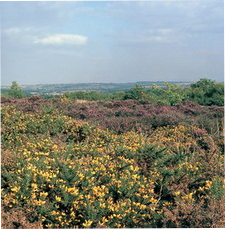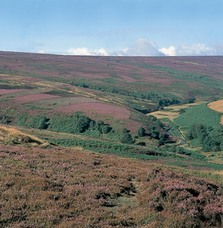

Biodiversity
Action
Plan
Heathland – whether heather-clad moorlands or open areas of
heather and bilberry sometimes peppered with gorse - enlivens the landscape, and is attractive to both people and wildlife.
Cleared from woodland on poor acidic soils or where peat is thin, the purple-carpeted heaths are maintained by grazing, scrub clearance and sometimes periodic burning.
Two forms of heathland are recognised - the Upland Heathland moors and Lowland Heathland below them …
Upland Heathland covers extensive areas of the slopes of the Dark Peak moors in the west of Barnsley, above the enclosed pasture land.
Due to the altitude and prevailing weather conditions, special communities of flora and fauna are found in the habitat: Upland Heathland is home, for the whole or part of the year, to an impressive range of birds including Red Grouse, Merlin, Ring Ouzel, Stonechat, Curlew, Golden Plover, Dunlin, and Snipe.
The distinctive Mountain Hare is found here as well as the Common Lizard. Invertebrates are especially diverse and include Emperor Moth and Green Hairstreak butterfly.
Lowland heath is rather scarce and fragmented in Barnsley, found on the slopes of sandstone hills, on former commons, and on where the conditions are right, on former pit-stacks.
The scarce Nightjar uses Lowland Heathland as its primary habitat and heathland also supports Linnet, Whinchat, Stonechat and Wheatear.
Brown Hare and Common Lizard, are also found in this habitat as well as some highly specialised plants especially bryophytes and lichens, and invertebrates such as bumblebees and butterflies.
NB. Some of the heath on areas close to the 300 metre contour are intermediate between upland and lowland heath with some characteristics of both.




Heathland